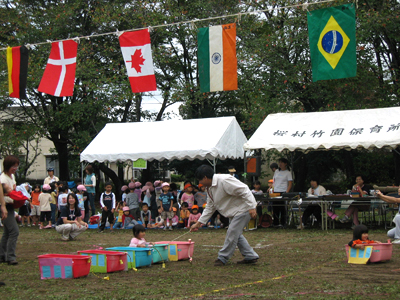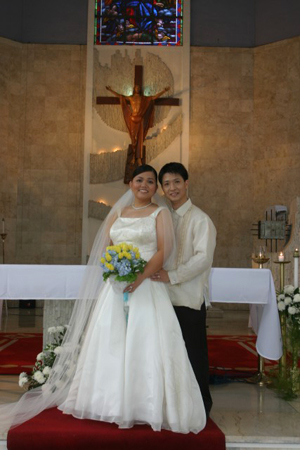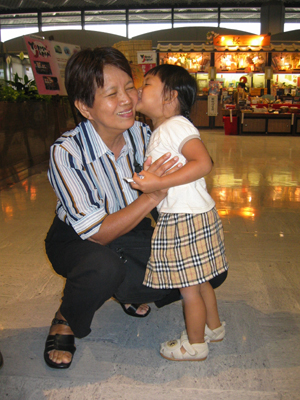This year is Aya’s third year at the daycare, but this is the first time for her (and for us) to participate in the annual “undoukai” or sportsfest organized by the Takezono daycare. When she was in the “Tulip” class, or zero-old class, they as babies were of course exempted from participating. Last year, when she was in the “Bara” class or one-year-old class, we were in Florida the first week of October, so she also missed it. This year, we had no choice but to participate in the event – although begrudgingly so at first. The teachers had initially scheduled the event for October 5, and the children even had rehearsals weeks before the event. Alas, it rained on that day, so they postponed it for the following day – as long as it didn’t rain again. Well, the following day was a bit cloudy, and the ground was still wet from the previous day’s rains, but they decided to go ahead with it. So that means that we had to wake up very early for two consecutive days, because they make the decision about whether to hold the sportsfest or not on the day itself, quite very early in the morning. We had to wait for their call, at 6 am! Waking up early was also necessary, because we had to prepare Aya’s packed lunch for the day as well. At any rate, last October 6, I was really not in the mood for any sportsfest, and with such a gloomy weather outside, I couldn’t imagine how the kids would be able to enjoy it. I thought it was so cruel of them to subject the kids to some silly sportsfest. I mean, really, now! In this kind of weather?!! Bah, humbug. Call me the Mrs. Scrooge of sportsfest. This is not the olympics, baby, this is just the daycare sportsfest.

I was wrong on all counts. The weather sort of cooperated, with a bit of sunshine every now and then, and it even got quite warm sometime during 11 am or so. And oh boy, the kids had fun – their faces were beaming as they ran around the mini-oval. And the little kids in Aya’s class (2-3 year olds) were so AWFULLY CUTE while running like mini-athletes. The happy looks on their faces was worth every effort. It was the first time for me to participate in such an event – and so beforehand I couldn’t quite understand why we really have to bother with it, especially with kids at such a young age. I don’t recall having something like this when I was in preschool! Actually, I don’t think we have sportsfests for elementary children in the Philippines. Well, at least that goes for my experience in public schools. I reckon the private schools might organize something like this.
Twice I watched the video we took, and each time I could see how this sportsfest was worth every parent’s time and effort. I took a day’s leave from the office, and Baggy had to sacrifice four hours of his attendance to work. In my opinion, every dad of every kid there should try their darndest to attend it – sadly, about 70% of the parents there were “okaasans” (moms). The “otoosans” (dads) were obviously too busy with their work or whatever else.
The children not only had fun – they learned about teamwork and performing with one’s best. The parents constantly shouted, “Gambare!” (do your best) while their little ones romped around the field. I particularly liked the “track-and-field” game. Sometimes a kid would skid or stumble. But he/she would be cheered on by parents and teachers and would be encouraged to still finish the game by all means. I don’t know, I was just so moved by all of it.
All classes had games were the children were able to participate with their parents. Take note, there were no losers and winners. No individual was honored because he/she finished first, or ran the fastest. It was no place for individual recognitions, just friendly games of sorts where everybody could have a good time. Everybody got a medal. The five-year-olds got the real gold medals, though, while the other classes got these cute paper medals prepared by their teachers. They get the real ones because they will be graduating at the end of this fiscal year and will be moving on to kindergarten the following year. Also, all children were also rewarded with “Shabon dama” or bubble-making contraptions after the games.
Can’t wait till next year’s sportsfest!





